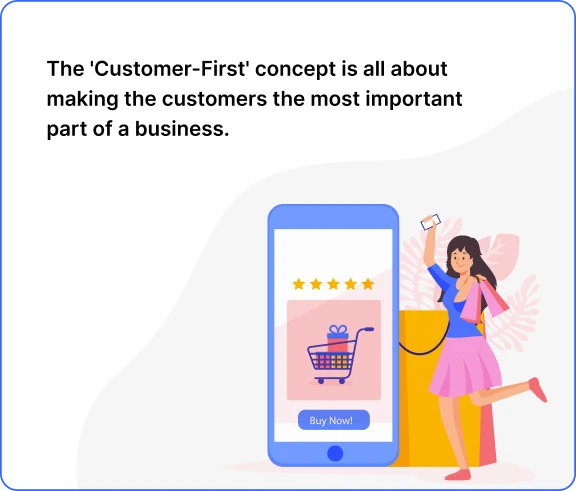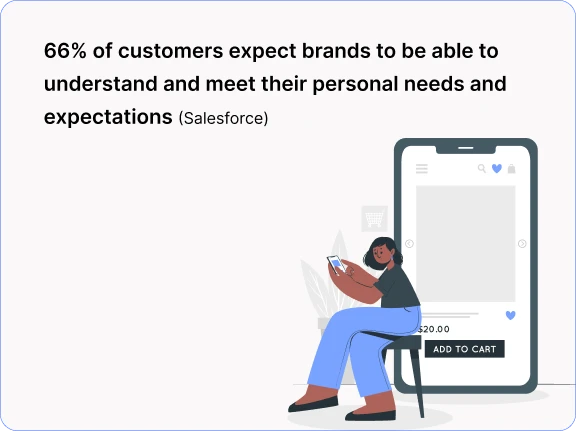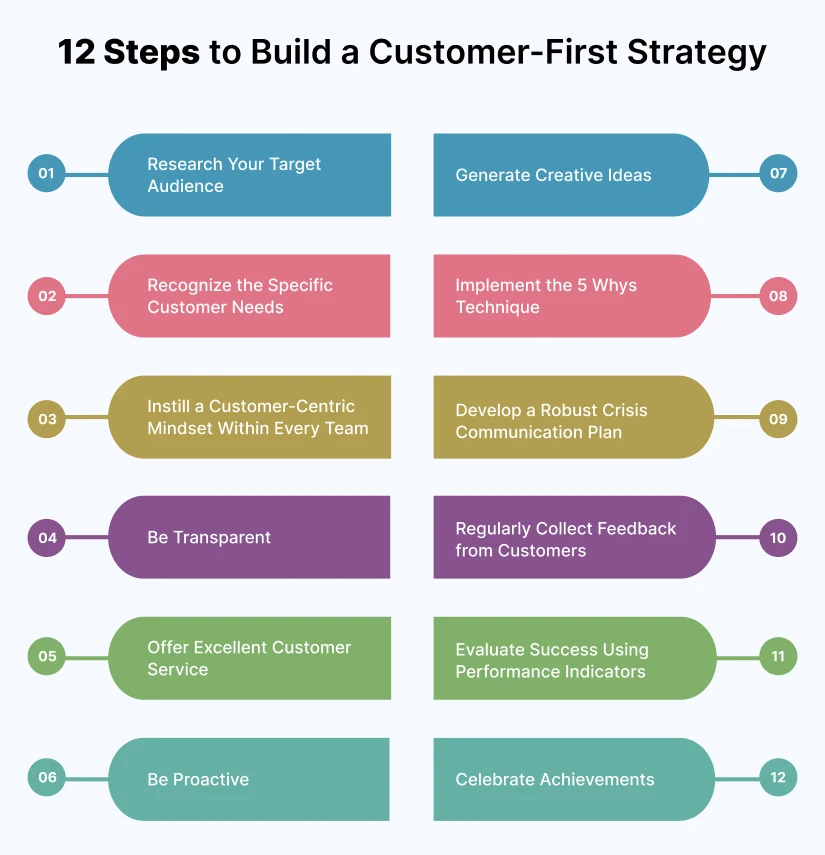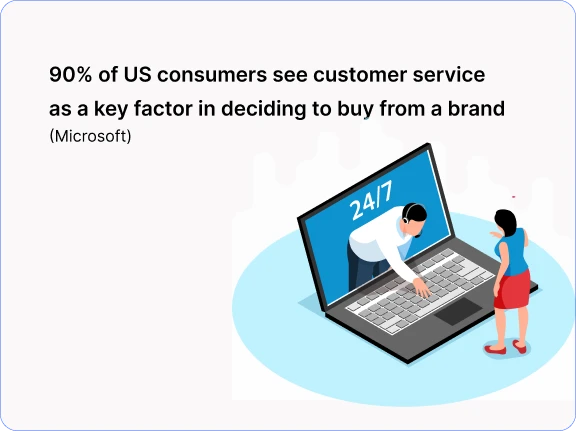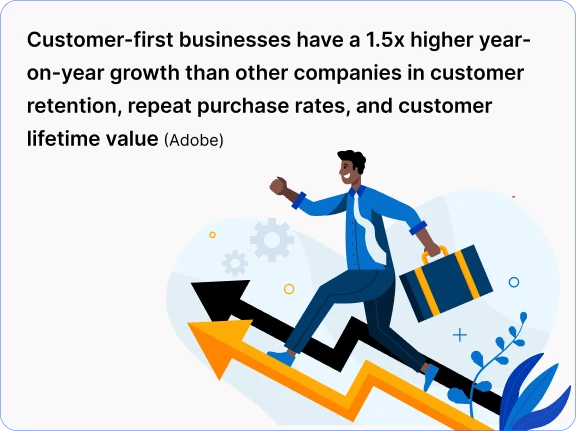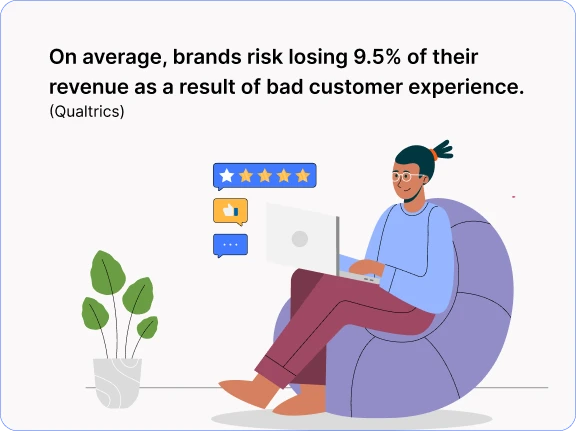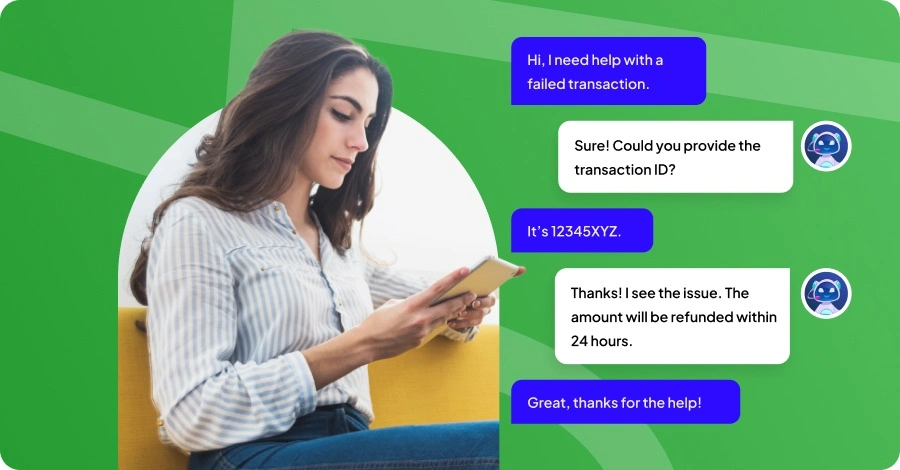How to Build a Strong Customer First Strategy: A 12-Step Guide
- April 25, 2024
- 16 mins read
- Listen

In today’s world, customers hold a lot of power. They choose whether to shop online or in-store, and they have a big say in how companies should sell to them, advertise, and make their shopping experiences better.
A customer-first approach means making everything in a business revolve around the customer. But just saying “the customer is always right” isn’t enough – you need a plan to make it happen. Successful companies find a balance between satisfying customers and reaching their own business goals. They create marketing plans that attract customers while also working well for their employees and clients.
Today we will discuss more about the ‘customer first’ concept, what is achievable when companies prioritize their customers above all else and the best strategies to implement in your own business, yielding superior results and enhanced customer experiences.
What is the Customer First Approach?
Instead of just thinking about products or services, it’s all about thinking about what the customer wants and needs. This means making sure every interaction with the customers is positive and meets their expectations.
How to keep the customers happy? The goal is to always give them the best service possible. When you prioritize customers, you think about how your every decision or action might affect them. Instead of organizing everything around the product or how the business operates, customer-first companies focus on giving customers the best experience.
While developing a customer-first culture in your office also consider the requirements of your employees. If employees feel valued and happy, they can do a better job of taking care of the customers. And if customers are happy, employees feel good about their work too.
Benefits of a Customer First Strategy
Next, let’s look into some stats now.
84% of companies that focus on enhancing their customer experience see a rise in their revenue. 73% of consumers believe that having a positive experience greatly influences their loyalty to a brand. Therefore, prioritizing your customers and consistently placing them at the forefront of every business decision is really important if you want to stand strong in the competitive business domain.
Putting customers first helps your business understand its target customers better. It lets you develop products and services that the customers actually want. It also makes customers stick around your brand and keeps your employees happy because everyone is happy with the outcome. Let me break down the benefits for you!
-
Enhanced Customer Satisfaction
Placing customers at the forefront of business decisions ensures that their needs and preferences are always considered. This leads to higher levels of satisfaction as your customers feel valued and as they can see that you are prioritizing their needs before your business growth. When customers are satisfied, they are more likely to return to your brand to buy more and recommend your business to others.
-
Competitive Edge
Implementing a customer-first culture in your business not only drives profitability but also ensures employee satisfaction and boosts your brand reputation. This gives you a big edge over your competitors who may not follow this customer-centric approach.
-
Higher Employee Retention Rates
According to a survey conducted by SurveyMonkey, employees have highlighted a direct correlation between finding their work enjoyable, meaningful and factors such as customer empathy, impact, and satisfaction. When employees see the positive impact of their efforts on customer satisfaction and business success, it boosts morale and job satisfaction. Employees who feel empowered to prioritize customer needs are more engaged and motivated in their roles.
-
Customer Loyalty
By consistently delivering excellent experiences and addressing customer concerns promptly, you can earn the loyalty of your clientele. Loyal customers are more likely to make repeat purchases, resulting in higher lifetime value and reduced customer acquisition costs. Furthermore, your loyal customers also work as brand advocates, promoting your business to their friends, family, and social networks.
-
Detailed Customer Insights
A customer-first approach helps you to collect data about your customers from different sources and platforms. Analyzing this data gives you valuable insights into your customers like their purchasing behavior, preferences, thoughts, and requirements. You can then use these insights to improve your products or services, make better decisions, and discover new growth opportunities.
-
Reduced Churn
By prioritizing customer satisfaction and delivering exceptional experiences, you can reduce customer churn rates and improve customer retention. Addressing customer concerns promptly and proactively resolving issues helps to build trust and loyalty among customers. Additionally, ongoing communication and engagement with customers can help you identify and address potential sources of dissatisfaction before they escalate.
-
Continual Company Growth
The customer-first culture is the key for brands to expand. Here I am not just talking about steady income—I mean getting referrals from customers regularly and more people knowing about your products. Happy customers don’t just protect your business during tough times, they also help it grow by telling others about it.
The more people come to know about you, the more you will get the chance to convert them into your paying customers.
How to Build an Effective Customer First Strategy: 12 Steps
Having a customer experience management strategy is key to being a customer first organization. Building such one involves a comprehensive approach that prioritizes understanding and meeting the needs of your customers. Here are 12 steps to help you develop and implement a successful customer-first strategy.
1. Research Your Target Audience
Just understanding your customer’s buying behavior is not enough—you also need to know who they are. Understanding your target audience deeply and how your business helps to improve their experience is key.
To get to know your target audience, do thorough research, look at data, and ask customers about:
- Their pain points
- Hobbies and habits
- What they like
- What they dislike
- Shopping patterns
- Their age, where they live, and other basic info
- Preferences
- How much they’re willing to pay
- Thoughts and values
Making a detailed buyer persona can help you target better. The buyer personas are the detailed profiles of your ideal customers. It includes things like their age, gender, where they live, what they like and don’t like. When you make buyer personas, you can use this info to make your customers’ experiences more personal.
2. Recognize the Specific Customer Needs You are Catering To
Once you know who your customers are, focus first on understanding their basic requirements as individuals, and then think about how your company can help them. This will help you figure out which goals or needs your company should focus on. Understanding what your customers want will help you improve your products and services to better meet their needs.
Imagine the journey your customers go through from when they first learn about your brand to when they buy something and even afterward. Think about all the different stages in the customer purchase journey when they interact with your brand and what they might need during each step. This will help you create experiences that make them happy and satisfied.
You can learn about your customers by:
- Doing market research
- Asking customers questions in surveys
- Looking at what your competitors are doing
- Keeping an eye on what people are saying on social media
If you can solve a specific problem that your customers are dealing with, you’ll stand out from other businesses and attract more customers.
3. Instill a Customer-Centric Mindset Within Every Team
To embed a customer-first strategy within your organization, it’s crucial to instill a customer-centric mindset within every team. Firstly the company leaders should demonstrate and prioritize customer-centric behaviors in their own actions and decision-making processes. When employees see leaders embodying a customer-first mindset, they’re more likely to follow the same.
Clearly communicate to all teams why being customer-centric is essential for the success of the business. Help them understand how their roles contribute to improving customer experiences and achieving organizational goals.
It’s true that the customer service team talks to customers the most each day and should prioritize them, but that doesn’t mean other teams can ignore it. Many companies think this way but it’s absolutely wrong. This approach undermines the effectiveness of the entire concept because a company comprises more than just the customer service team. Every team within the company holds responsibility for delivering a good customer-first experience, and none should be overlooked in this regard.
4. Be Transparent
Be open and honest with customers about your products, services, and practices. It involves providing clear and accurate information, addressing concerns openly, and being upfront about any changes or issues that may affect them.
Customers usually want instant assistance with their queries. The longer they have to wait, the more annoyed they become. However, sometimes you may not be able to solve every customer complaint right away. Surprisingly, prioritizing customers can sometimes backfire. When you can’t fulfill a customer’s request, it’s important to explain why.
Always be transparent and communicate your limitations. Simply put, be honest about the situation. Customers like honesty, so let them know about any challenges you’re facing and when their issue will be resolved. I am sure they will understand.
5. Offer Excellent Customer Service
Provide instant assistance whenever they need it. While buying your product and during product research and even after the purchase, customers may need help and expect you to be there always.
According to research by Salesforce, 75% of consumers are likely to continue doing business with a company if its customer service is excellent, even if the company has made a mistake. So, offering excellent customer service is important if you really want to do well in your business and stay ahead of your competitors. Offer instant assistance on your website, mobile apps, and other social media platforms where your customers are.
To manage every interaction from a single point, you need to opt for AI-powered customer service tools. These tools not only offer real-time assistance but also let you offer service 24/7 even after your business horse.
6. Be Proactive
Offer proactive customer service if you want to take the customer-first approach. Reach out to your customers proactively on their preferred platforms and offer assistance to them even before they ask for it.
Instead of waiting for customers to reach out to support when they have a problem, being proactive and customer-focused brings several benefits:
- Happy and satisfied customers
- Better retention rates
- Increased sales
- Customer loyalty
- Improved brand reputation, and
- More time for your team
Proactive customer service relies on effective communication platforms. Many all-in-one customer service solutions are available to choose from, allowing you to go omnichannel and integrate automated support into your routine.
These platforms offer various tools like live chat, chatbots, help desks, knowledge bases, ticketing systems, and email marketing, making your proactive customer service the best. With these tools, your support agents can monitor customers across their preferred platforms in real-time and reach out to them proactively.
7. Generate Creative Ideas to Enhance the Customer Journey
To prioritize customers, it’s essential to think innovatively about enhancing their experience. This involves identifying their pain points, brainstorming creative solutions to serve them better, and opting for the latest technologies such as AI.
Innovation serves as a vital element in a customer-first approach, indicating an understanding of customers’ current needs and an ability to anticipate their future requirements. If you keep working on new ideas for offering the best to your customers, you will surely make them happy and satisfied.
8. Implement the 5 Whys Technique
The 5 Whys technique originated in the Toyota Motor Corporation as part of its problem-solving training. This method involves asking “why” five times to uncover the root cause of a problem and prevent it from happening again. Here is one example for you!
Problem: Your yearly sales have decreased.
- Why have sales decreased?
Because fewer customers are purchasing our products.
- Why are fewer customers purchasing our products?
Our prices are higher compared to those of other competitors.
- Why are our prices higher than competitors?
Because our production costs have increased.
- Why have our production costs increased?
Because we’ve switched to a more expensive supplier.
- Why did we switch to a more expensive supplier?
Because our previous supplier couldn’t meet our production demands.
By asking the question ‘why’ five times, we’ve identified that the root cause of decreased sales is the inability of the previous supplier to meet production demands, leading to higher costs and ultimately higher prices.
9. Develop a Robust Crisis Communication Plan
Crises are inevitable occurrences. However, we can prepare ourselves to tackle them effectively when they arise.
Developing a robust crisis communication plan is really important for any organization that prioritizes its customers. Identify potential crises that could impact your organization and its customers. These could include natural disasters, product recalls, data breaches, or public relations issues. Assemble a cross-functional team with representatives from key departments such as communications, customer service, marketing, legal, and senior management. This team will be responsible for developing and executing the crisis communication plan.
10. Regularly Collect Feedback from Customers
To understand if your customer-first strategy is effective, you need to hear from your customers directly who are using your products or services. Regularly asking them for feedback through surveys—like every three months or twice a year—can help you understand them better. Pay attention to what they say and use it to make important decisions and further betterment.
Surveys give you data on what your customers like and don’t like, making it easier to improve your products or services. They also show how happy your customers are, helping you make changes to keep them satisfied and loyal.
Don’t forget about your employees—they’re just as important as your customers. Ask them regularly how they feel about the strategy and if they have any suggestions for making it better. Their happiness is important for your success too.
11. Evaluate Success Using Performance Indicators
Assessing the success of your customer-first strategy requires using the right measurements. Instead of solely focusing on traditional metrics like sales numbers or profit margins, consider other indicators that reflect customer satisfaction and loyalty. Such as:
- Customer Satisfaction Score (CSAT)
- Net Promoter Score (NPS)
- Customer Retention Rate
- Customer Churn Rate
- Customer Lifetime Value (CLV)
- Average Order Value (AOV)
- Repeat Purchase Rate
- Social Media Engagement
- Online Reviews and Ratings
- Customer Feedback Volume
Among these metrics, there are 2 that will tell you if your customer-first approach is doing well or not: NPS and churn rate. NPS asks one simple question: Would you recommend our product to someone you know? Changes that make customers happier will raise this score, showing if your strategy is working well or not.
The churn rate shows if customers will stick around or stop using your product. Lower churn shows customers are happy and they will continue using your product.
12. Celebrate Achievements
Research shows that lack of recognition continues to be one of the primary reasons why employees choose to leave companies.
When you celebrate success, you acknowledge and appreciate moments where your team goes above and beyond to serve your customers well.
Nearly 88% of employees acknowledging good work is essential. Therefore, as a business owner or team leader, you should offer incentives for exceptional performance.
Whether it’s hitting a milestone in customer satisfaction scores, receiving glowing feedback from a satisfied customer, or achieving a significant increase in customer retention rates, taking some time out to celebrate these wins helps reinforce the importance of prioritizing customer needs within your organization.
By highlighting and rewarding achievements, you not only motivate your team to continue delivering exceptional customer service but also foster a culture that values and prioritizes customer-first culture at every level.
Customer First Companies: Real-World Examples
-
Target
Target, also known as Target Corporation, is a big store company in the United States known for its customer-first culture.
Target cares a lot about what its customers like and want. It offers things that customers like best. When you walk into a Target store, you’ll notice that everything is set up to make your shopping experience great. The stores are big, bright, and easy to find your way around. They even have special areas like cafes and interactive displays to make shopping more fun. Their website and app are also easy to use and offer facilities like fast delivery and picking up your order from the store etc.
During the COVID-19 pandemic, Target did a great job of taking care of its employees and customers. They gave their employees more benefits and financial support during that tough time. Target also did more to let customers shop without going into the store, like using the drive-up service.
-
Zappos
Started in 1999, Zappos is an American online store offering fashion and lifestyle products like shoes, clothes, bags, and more for men, women, and kids. People really like Zappos because they have great customer service. They are open to help customers 24/7, have an easy return policy, and free shipping. Zappos also actively contributes to the community by supporting various charitable causes that focus on promoting education, and environmental sustainability.
Zappos truly values its customers, and here’s a heartwarming example: A customer purchased shoes for her father but later he passed away. When the customer decided to return the shoes, Zappos not only allowed her to keep the shoes but also sent a bouquet of flowers to express their sympathy and support.
How REVE Chat Helps to Offer Customer First Experience?
Putting customers first means making them the most important part of every decision a company makes. This kind of culture is focused on meeting customers’ needs in the best possible way.
To create a customer-first culture, businesses need to do more than just say they care about customers. They need to make sure their employees have the right tools and technology to give customers a personalized experience and also customers get benefitted. Platforms like REVE Chat can help with this.
REVE Chat is an omnichannel customer engagement software that lets you offer great customer service on your website, mobile app, and social media platforms like Instagram, Telegram, Viber, Facebook and WhatsApp. With REVE Chat, you can offer real-time assistance 24/7 even after your business hours. Your team can see all customer messages in one place, so they can respond quickly and personally.
REVE Chat also offers an AI-powered chatbot to automate various business operations including support, so that your customers get assistance even when your team is busy or it’s outside regular working hours.
Want to see how REVE Chat can help your business? SIGN UP for the 14-day FREE TRIAL today.

